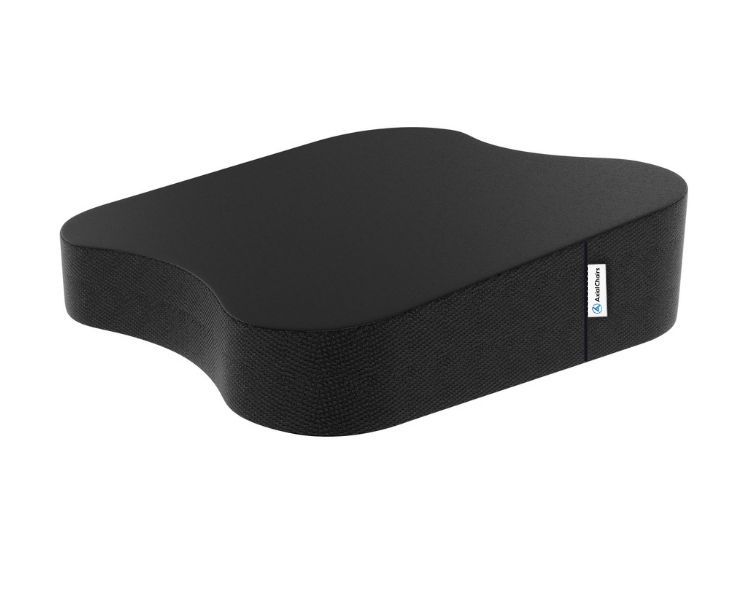When it comes to SI joint (sacroiliac) pain, patients often want to know if the discomfort and other symptoms will eventually go away. As a physician, I understand how worrisome this can be – after all, experiencing any amount of chronic joint pain is tough to deal with and can have a serious effect on your quality of life. Fortunately, there are some things we can do that might help provide relief and even bring about total resolution in appropriate cases. In this blog post, I’ll discuss the potential causes of SI joint pain, provide tips on ways to potentially lessen your current symptoms as well as offer information regarding recovery periods you may experience while healing from an episode of sacroiliac joint discomfort.
As a general rule, SI joint pain can go away with proper diagnosis and treatment. However, if left untreated, it can become chronic. Common causes include injury or pregnancy. Treatment options include physical therapy, medication, and surgery. Ergonomic seat cushions can provide relief and prevent future episodes.
Join me in uncovering the most successful approaches for relieving SI joint pain. My three-decade-long career in chiropractic, combined with my training in ergonomics, has allowed me to become an expert in posture. My work includes a published book, national television exposure, and the development of various products designed to promote better posture and comfort while seated. Additionally, I spearheaded a successful Kickstarter campaign to fund ergonomic seat cushions. With this expertise, I can offer valuable advice that may lessen or even abolish sacroiliac pain.
Sacroiliac Pain: The Fundamentals of Recovery
First, let’s talk about the SI joint itself. The sacroiliac (SI) joint connects your sacrum – the triangular bone at the base of your spine – to your ilium, which forms part of your pelvis. This joint is essential for transmitting forces between your upper and lower body, and it’s a critical component in maintaining spinal alignment and stability.
Now, the million-dollar question – will SI joint pain go away? The answer is a resounding “yes,” but it requires a combination of appropriate treatments and lifestyle adjustments.
From my clinical experience, one of the central mechanisms for sitting without causing pain in the knees or exacerbating SI joint discomfort is maintaining proper spinal alignment and a balanced, strong core. A healthy core helps support your spine, taking some of the pressure off the SI joint and other vulnerable areas.
One piece of advice I always give my patients is to use an expert-designed ergonomic seat cushion when sitting for extended periods. My personal favorite is one made with a natural latex top and a high-density base layer foam. This type of cushion provides excellent support, promotes proper posture, and can help alleviate SI joint pain.
All Day Comfort & Support
Assembling an Ergonomic Chair: Guidance and Ideas
To optimally handle your seating situation, it’s crucial to examine various factors, with chair modification being an important component. A variety of techniques can be employed to achieve this, including adding a specially designed seat pad and lumbar support. These features can ease the burden on your back and legs, improving comfort and encouraging proper posture during long periods of sitting. Moreover, confirm that your feet are securely on the ground and that there’s ample room between your chair and desk. By following these recommendations, any basic rigid chair can be transformed into an ergonomic haven that fosters long-term health and wellness.
I explain the concept of my ergonomic design on a TV show HERE
Ergonomic Sitting Support
An ergonomic seat wedge (pictured above) can be utilized to accurately position your spine and enhance stability. This high-quality natural latex cushion contributes to developing core muscles while alleviating tension in other areas, such as the neck and shoulders. Furthermore, sitting upright exerts less strain on your hips and knees, as it engages more muscle groups simultaneously compared to resting on a cushioned surface. This upright stance helps avert strain-inducing habits that people may inadvertently develop while working.
BTW, you may be wondering why I don’t recommend memory foam. While memory foam may be popular, I believe that it lacks pressure support and resilience. Additionally, memory foam can be a toxic material that heats up when you sit on it for extended periods, making it uncomfortable and potentially harmful.
Apart from using an ergonomic seat cushion, I also encourage my patients to adopt a regular exercise routine focused on strengthening the core and improving flexibility. This can include Pilates, yoga, or other targeted workouts designed to support spinal health and alleviate SI joint pain.
Of course, seeking professional help is always a good idea. As a chiropractor, I can provide personalized treatments and recommendations to help you manage your SI joint pain effectively. We can work together to identify the root cause of your pain and develop a plan that best suits your needs and lifestyle.
Best Seat Cushion for SI Joint DiscomfortAxial Ergonomic Seat Cushion® | Seat Chair Wedge
Quick Guide: A 30-Second Summary

All Day Comfort & Support
Product Name
Axial Designs™ Seat Cushion
Price
$149
Warranty
1 Year
Type
Posture Wedge
Top Layer
100% Natural Latex (Molded)
Bottom Layer
High-Density Foam
Top Material
Isometric Grippy Vegan Leather
Bottom Material
Non-Slip Material
Side Material
3D Breathable Fabric
3 Tests to Tell You if Your Back Pain Is Caused by SI
I know how you feel, as sacroiliac (SI) joint pain can be quite bothersome and persistent. Here are three tests I often use in my clinical practice to help determine if your back pain is caused by SI joint dysfunction:
The FABER Test: This test involves lying down on your back with the affected leg crossed over the opposite knee. I gently press down on the raised knee and the opposite hip. If you experience pain in the SI joint area, it could be a sign of SI joint dysfunction.
The Compression Test: While you’re lying on your side, I apply gentle pressure to the top of your hip. If this causes pain in the SI joint, it might be an indication of SI joint dysfunction.
The Gaenslen’s Test: You’ll lie on your back with one leg bent at the knee while the other leg is extended. I then apply pressure to both the bent knee and the extended leg. If you feel pain in the SI joint, it could be due to SI joint dysfunction.
How to Sit With SI Joint Pain
When it comes to sitting with SI joint pain, proper spinal alignment and a balanced and strong core are essential. Here’s what I recommend:
- Use an expert-designed ergonomic seat cushion made with a natural latex top and a high-density base layer foam. This type of cushion will provide the support and comfort you need, without the drawbacks of memory foam.
- Sit with your feet flat on the floor and your knees at a greater than 90-degree angle. This helps distribute your weight evenly and reduces pressure on your SI joint.
- Maintain a slight arch in your lower back by engaging your core muscles. This supports proper spinal alignment and further reduces stress on the SI joint.
SI Joint Pain Exercises to Avoid
I’ve written a complete hands-on review about the best sitting position for sciatica, and here is what I tested best with my sciatica patients.
While exercise is generally beneficial, there are certain activities you should avoid if you’re experiencing SI joint pain:
- High-impact exercises: Activities like running, jumping, and plyometrics can exacerbate SI joint pain. Opt for low-impact activities like swimming, cycling, or walking instead.
- Heavy weightlifting: Lifting heavy weights can put too much stress on the SI joint. Stick to lighter weights and focus on proper form to avoid aggravating the pain.
- Deep squats and lunges: These movements can cause excessive strain on the SI joint. Modify these exercises by performing partial squats and lunges, or avoid them altogether if they cause pain.
How to Unlock SI Joint by Yourself
In some cases, you can alleviate SI joint pain by performing self-mobilization techniques. Here’s one method I’ve found effective:
- Lie on your back with both knees bent and feet flat on the floor.
- Place a small pillow or folded towel between your knees.
- Squeeze the pillow or towel with your knees while gently pressing your lower back into the floor.
- Hold this position for 5-10 seconds, then relax. Repeat 10 times.
Always consult a healthcare professional before attempting self-mobilization to ensure you’re doing it safely and effectively.
All Day Comfort & Support
How to Sleep With SI Joint Pain
I know how you feel; sleeping with sacroiliac (SI) joint pain can be a challenge. But don’t worry, I’m here to help! Based on my clinical experience, finding the right sleep position is essential to alleviate your discomfort. Here are a few tips to help you sleep more comfortably:
Sleep on your side: Lying on your side with a pillow between your knees can help maintain spinal alignment and reduce pressure on your SI joint. Ensure that your top leg is slightly bent and not straight, as this will also help keep your spine aligned.
Use supportive pillows: Besides placing a pillow between your knees, using an additional pillow to support your head and neck is crucial. It will help maintain proper spinal alignment and reduce any strain on your SI joint.
Invest in a quality (natural Latex) mattress: A supportive mattress plays a significant role in keeping your spine aligned and reducing pain. Look for one that provides adequate support to your body without being too firm or too soft. My best recommendation is to get a natural latex (medium firm) mattress.
Final Thoughts
Ultimately, SI joint pain is something that can affect the overall quality of your life. Whether it’s chronic or acute, it can range from inconvenient to debilitating and should be discussed with a doctor to determine what kind of treatments are necessary. The underlying cause may not always be easily identified which can add an extra layer of difficulty in finding a resolution. While recovery rates vary depending on individual cases, early identification and proactive steps can help ensure the best possible outcome in dealing with SI joint pain.
It’s important to remember that addressing SI joint pain takes time and patience but you don’t have to go through this alone. Reach out to a professional who has experience helping patients through this health matter, find comfort in the support system around you and focus on taking proactive steps towards treating your SI joint pain. All in all, we hope that this information gave you better understanding of the condition as well as some insight into managing it – if this is something you’re experiencing right now, know that there’s hope for finding relief!







